
Sgor Mor from Carn Crom. From some elevations the long ridge looks quite dramatic, but mostly it’s the most unprepossessing of hills.
When I was a bairn my father and uncle referred to it as Finniscoor, having picked that name up from some of the local keepers. According to the map, Feith na Sgor (bog stream of the peaks) is just the large, open corrie to the south of the Sgor Mor-Sgor Dubh ridge, well living up to its name, but I’m assured by Joe Dorward, who researches such things, that it doe indeed refer to the whole hill mass between Lui and Dee. However, if people these days refer to the hill at all (it’s a Corbett, so people do climb it) it’s simply as Sgor Mor, after its highest top.
Anyway, I’ve had a fondness for this little-regarded hill for many years, and was quite pleased to see one of its rock features crop up on twitter recently – one of several near perfectly round rock basins to be found near the summit. Honestly, they’re worth the climb just to see them alone, but they’re like so much of this hill: delights to be seen through close examination rather than from afar.

The round rock ‘basins’ near the summit of Sgor Mor. Each is about 18 inches across and flat bottomed.
Yet even when they climb it, most people seem to skim the proverbial surface. The views, especially looking north into the main Cairngorm hills, are superb, as is the case with many a smaller hill, and many may appreciate the relatively easy going between the main Sgor Mor top and the slightly lower Sgor Dubh, but it’s a hill that tends to be climbed, traversed and descended by the same linear route, leaving so much unexplored. For me, though, my acquaintance began with a treasure hunt and has continued that way ever since.

Sgor Mor is ideally placed for views into the western and central massifs of the Cairngorms. Here you’re looking across the shoulder of Carn Crom on the right and Carn a Mhaim on the left to Ben MacDui, with Braeriach in the background.
I first became aware of Sgor Mor through a trip with my father, looking for a bottle of paraffin he’d left in a cleft in the rocks at Creag Phadruig there way back in the late 1940s. He always claimed that he and his pal Bruce (I forget the second name) would sometimes take a ‘short-cut’ over Finniscoor to camp at the Robbers’ Copse, and on one of these occasions they had stashed a glass demijohn of paraffin to save weight. Long gone, of course, but back then in the late ’60s we enjoyed poking around in the broken rocky outcrops above the track west of Linn of Dee, all the time convinced we were about to strike it lucky. I confess, I’ve had a kick around that area a few times since.
Many years later a friend took me up on that hillside promising to show me something. We walked scarcely more than 10 minutes from the Linn of Dee then started up the hillside, stopping after a rough climb just before a very large boulder.
“We’re here,” he said.
“Where?” said I.
“Look at your feet,” said he.
And there, at my feet, was a Lilliputian door in a recess under the rock. Lifting the door away, we crawled into a cave large enough for three adults to sit or sleep (if not to actually stand). The sides were built up with rocks cemented into place and the perfect wooden floor a work of art. It was a great howff, handy for a late drive up and I was saddened a few years later to find, arriving on a dark and drizzly night, to discover someone had broken down the walls and burnt out the floor.
(Proving what a small world it is, some years after that I discovered that it had been one of the Cairngorm bothy crew – Kenny Freeman – who had constructed it.)
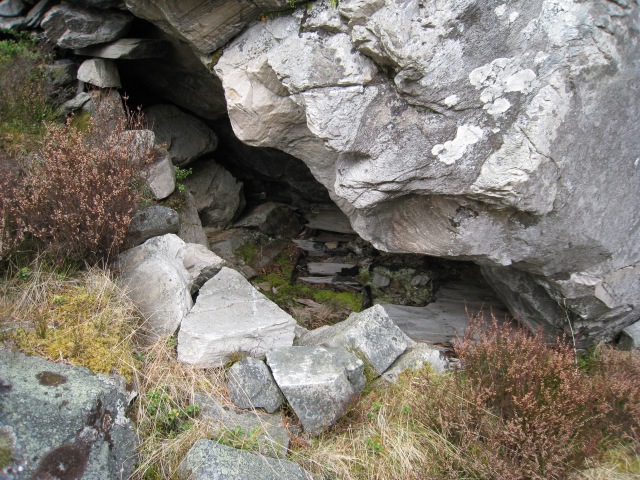
All that’s left of Kenny’s Howff. You can see the burnt out wooden floor, but the walls have been destroyed. Entry was by crawling in at the front.
If you walk past the site of the former howff and the mythical paraffin stash, you come on two or three gullies disappearing up the hillside. I now know that down in the Lake District there are many who specialise in ‘gill scrambling’ but so many years ago it was just curiosity that led me up one of these gullies rather than any notion it was something people do. I found a rose. A rose in bloom no less. Yellow and a cultivated variety rather than wild, so who knows how it got there. It was a freak, but the whole environment in the sometimes precipitous, steep-sided gully was markedly different from that ‘outside’ on the lightly forested open hillside.
That day I kept in the groove until the angle leaned back and the banks lowered in height until I could see over the sides, looking out onto the map’s Feith na Sgor, a great, wide, shallow corrie. I stayed at the banks of the Allt nan Leum Eassainn until the last climb up to the spine of the hill, as so often finding the banks of a burn the driest and firmest route through boggy ground.
More recently, on the north of the hill, I’ve followed the Allt a Choire Duibh, not so steep but still offering some entertaining scrambling up the rocky stream bed and with the benefit of those superb views into the main Cairngorms, evolving as height is gained.

…and always those great views behind. This is looking up past the east face of Carn a Mhaim to Sron Riach and Coire Sputan Dearg of Ben MacDui
You could follow the burn right up to the rather boggy col between the main top and the irresistable rocky subsidiary of Creagan nan Gabhar (no goats there for many a year though), but I was tempted by a steep heather fight up to the ridge near the top.
And that ridge is a curiosity: a dry gravelly spine sandwiched between two bogs and punctuated by granite outcrops, some big enough to tempt the adventurous into some bouldering fun and collectively giving the ridge a deceivingly dramatic profile from the north.
Another piece of deception is Creag Dhoin, the slabby ribs in the wide corrie overlooking the road between Black Bridge and Derry Lodge, giving the hill a freshly scraped look as through the glaciers had not long passed.
In fact when you get up amongst them, they lean back considerably and many can be walked up. One or two of the most westerly might offer some interesting bouldering for the determined, but mainly it’s just an interesting area to wander about it.

This slab might give some bouldering, although the steep slope at the bottom means a fall might end up a good way below the rock!

Perhaps more interesting than the slab above was this cigar of tightly rolled grass, found on the steep grassy slope below the rock. Never did figure an explanation for it, but there were several others like it.
Next time I’m up there I hope to follow what appears like a horizontal fault line making a natural traverse across the corrie. I may well get distracted (it’s happened before) but there’s a large and forbiddingly steep crag in a hidden gully to the east of the ribs which I’d like another look at too. We’ll see. The great thing about ‘Finniscoor’ is that half a century after falling into a gravel quarry at its foot on my first ever visit to the Cairngorms there are still bits I want to explore. And the great thing about the Cairngorms is that Finniscoor, Feith na Sgor, Sgor Mor, however you want to call it, is only one such hill of many. There is no end to the possibilities.




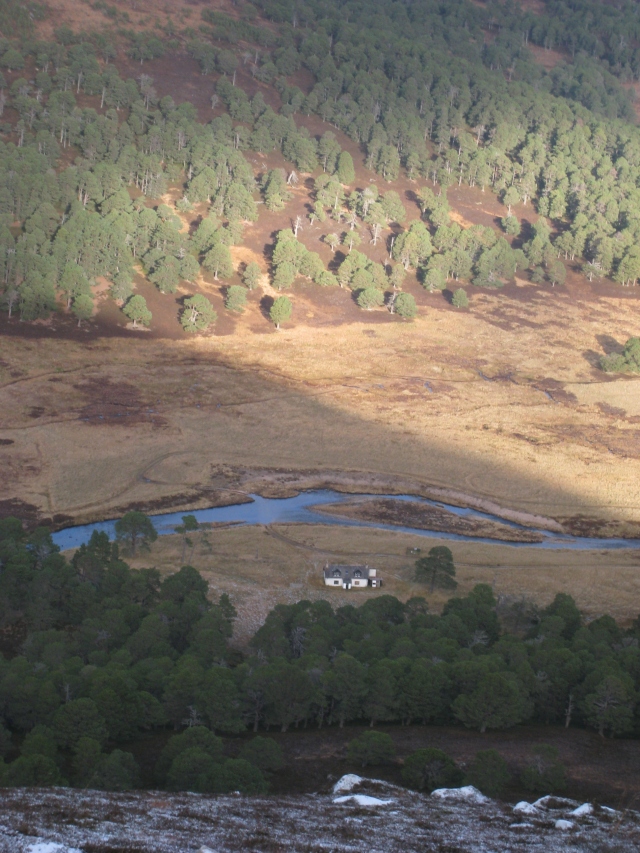

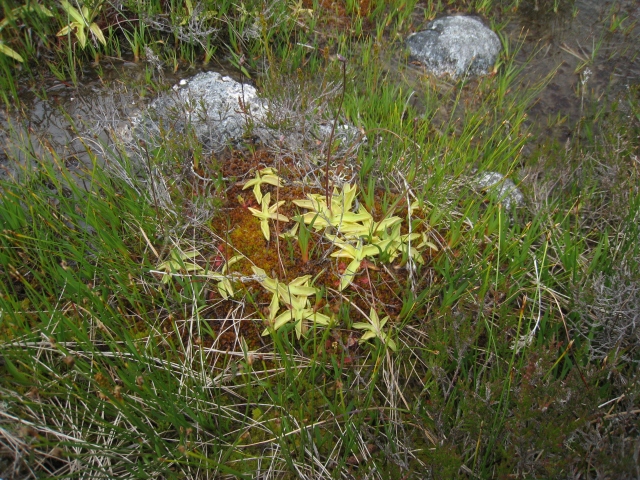
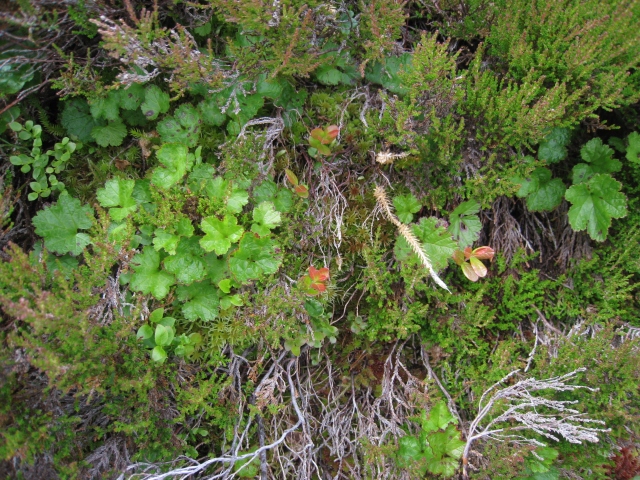
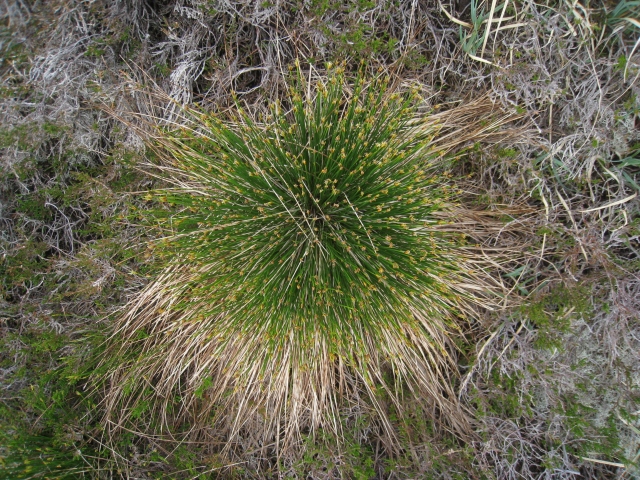

Another great story Neil. Keep them coming.
So, basically you were up there smoking grass! 😉 Love the grass cigars.
We have very round holes on our moor on top of the gritstone tors – but they don’t look as perfectly round as yours. They’re completely natural though.
Looks a great area to explore – I wanted to do Sgor Mor this March on my Braemar trip but I was pretty ill at the time and, when the weather cracked up the next day, I went off back home having achieved my Munro Top objective…
Carol.
Heh heh. Grass smoking days long gone. One suggestion I’ve had is that it could have been formed by snow sliding over the steep grassy slope during the thaw, but not sure.
It’s a hill to explore rather than just bag… but then so are they all in the Cairngorms. 🙂
I enjoy a little gill exploration myself – it’s great fun. I don’t really just ‘bag’ anything – I always have a good look around – well so long as the weather isn’t totally pants that is!
Have enjoyed a fine wander along the ridge a few times, as you say some great views especially near the summit. Generally find getting on and of a bit off an effort though with all the deep heather.
Its a mighty fine trek to just walk around it.
Must pay another visit and follow your lead and pay more attention to what’s closer to the ground.
Possibly the quickest way on and off it to beast it up the steep slope at the back of Luibeg Cottage, which takes you up to fairly easy walking on the plateau near Sgor Dubh. Some of the streams avoid the worst of the heather too, although some steeper bits can be quite loose and dangerous in the southern streams and banks. I think, in general, it’s just a hill that makes you work for your pleasures.
Not much nearer to a definitive answer on the rock-basins, but a discussion on similar features in the Sierra Nevada at this link.
http://calfire.ca.gov/resource_mgt/archaeology-Rock_Basins
I favour the explanation that natural depressions are enlarged with frost/ice and wind (but like many things, once a ‘feature’ is formed, it may be exploited by, or a focus for, other activity.
Also heard from my brother-in-law with this link – https://www.researchgate.net/publication/251250562_Cupules–_the_oldest_surviving_rock_art_Cupules–_the_oldest_surviving_rock_art which offers a similar explanation. I don’t think these are any form of rock art, but the link also talks of some very plausible chemical weathering in horizontal granite surfaces.
Great article Neil, as always.
As you described the howff, I immediately recognised it from the stories mum and dad have told me in the past. It was mum (Isobel), dad (Kenny) and Ruairidh Smith that built it. They carried in all the materials under the cover of darkness, travelling up on scrambler type motorbikes laden with wood and tools. They would drop the materials at the side of the track, hide the motorbikes in deep heather and carry the supplies up the hill in the moonlight. They dug it out, putting in a wooden floor, wooden door and built up the west facing wall with cement on the inside but nothing on the outside (keeping the outside as discreet and natural as possible). I also remember dad telling me they built a mound not too far from the front door and turfed it with heather so you could not see the door until you were right up to it.
Unfortunately, a keeper on that beat stumbled across the howff when he was out looking for foxes. This keeper had a bit of a dislike to walkers and climbers and true to his reputation, he then went back with a can of diesel and burned it out. Dad was informed by another keeper what had happened and decided it was pointless to rebuild it as long as that same keeper was working on the estate. I think it lasted around 2-3 years before it was burned down.
I’m sure I’ve seen photographs of it before it was burned out. I’ll ask him tonight and see if we can come up with anything.
Thanks,
Elaine
Thanks for that Elaine. I never had any photographs of it in use, but you’re right, there was a mound in front of the doorway which hid it until you were right up on it – I never realised it was deliberately build like that.
Could the rock basins be formed by a combination of wind, gravel and water?
Amazing video – erosion in action. I think that sounds pretty likely as to how the basins get wider and/or deeper, but I do wonder how they get started – maybe it’s a combination of the chemical erosion in the links in the comments above, and the water, wind and grit in this video. Fascinating stuff.
It’s probably to do with a weakness being exploited by erosion, such as freeze/thaw. That weakness could be crystals or granite of the Weetabix variety?
http://www.landforms.eu/cairngorms/weathering%20pits.htm
Alternatively, it could be down to faeries, as you say…
Great! Thanks for these links Scott – it all gradually penetrates my thick skull and builds up a more complete picture. 🙂
Aye Neil ,myself and an old climbing pal (Wullie Mcgregor ) fae Summerhill , we stayed a couple of times in Kenny,s secret howff . Elaine is correct ,i was told a keeper did stumble upon the howff and did the dirty deed .When i say stumbled upon , he probably heard of the howff , in the Mar lodge bar ! Wont go on any further and name the supposed said culprit….Original Bob Scott,s bothy comes to mind !!!!
Aye Ian, I’ve already edited Elaine’s post to avoid a potential lawsuit, and you’re sailing close to the wind yourself there. 🙂 Sad days that the bugger could have gotten off with all that, but they’re gone now and there was never the proof.
On another note…I recall Adam Watson,s book t……he Cairngorms, he said that ridge was one of the best routes in the gorms for nordic skiing.
Any chance of a re-build? Unofficial of course.
Couldn’t possibly comment, Sinbad. 🙂
fantastic little howff, came across one 2 yrs ago on dartmoor just enough to lie/sit in for two out of the wind a rebuild is in order..walls are still up.
Somewhere off-track up there, in the semi-open woodland, I once came across a white heather bush. I’ve looked for it again, but not found it.
It’s probably in the same place as my garden rose and Brigadoon! 😀
i remember sleeping in the Kenny’s cave for the last time round about 1986 (can’t be certain about year, but there about). Left the cave on a beautiful summers morning to walk over the plateau . To cut a long story short, me my pal and bothy the dug ended up walking far further than originally intended. By the time we got back to the Linn of dee we had walked well over thirty miles.glad to see the wee cave again and rest. great memories.
Good yarn, Neil. Enjoyed it.